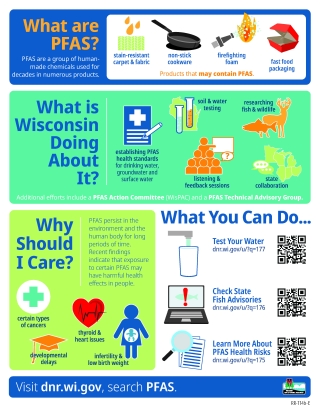PFAS Investigation and Cleanup
Per- and polyfluoroalkyl substances (PFAS) may enter the environment and result in contamination to groundwater, surface water, soil and/or sediment. In general, a person responsible for a discharge is required to report, investigate and cleanup the contamination. The person responsible is defined by law as one who "causes," "possesses" or "controls" the contamination (e.g., owns property with a contaminant discharge or owns a container that has ruptured).
When discharged to the environment, PFAS compounds meet the definitions of a hazardous substance and/or environmental pollution under state statutes (s. 292.01, Wis. Stats.). Discharges of PFAS to the environment are subject to regulation under ch. 292, Wis. Stats., and the requirements for immediate notification, investigation and remediation under chs. NR 700-799, Wis. Adm. Code. State definitions of "environmental pollution" and "discharge" of a "hazardous substance" are not the same as the definitions in the federal Superfund and Resource Conservation and Recovery Act laws and in some other states' laws. However, most environmental clean ups in Wisconsin follow state authority.
PFAS in Soil
PFAS in soil can contaminate groundwater and surface water, which could be used as a source of drinking water for humans. The health of animals that live in or consume the contaminated water could also be negatively impacted.
The RR Program has a spreadsheet with soil residual contaminant levels (RCLs) that were calculated using the U.S. Environmental Protection Agency's (EPA) Regional Screening Level (RSL) web calculator and following the procedures in Wis. Admin. Code § NR 720.12 for determining soil direct-contact RCLs protective of human health. There is no pre-determined, groundwater protective soil RCL for these compounds. Groundwater RCLs are calculated by the responsible party.
PFAS in Surface Water and Wastewater
The DNR's Water Quality program, in cooperation with the Fisheries program and other partners, monitors for PFAS in surface waters and fish. This ongoing work samples fish tissue and water for PFAS at select sites around the state near known or probable sources of PFAS. The information obtained through these sampling efforts allows for better understanding of where PFAS contamination is found in Wisconsin and areas where actions are needed to address the contamination.
In 2022, the DNR promulgated enforceable water quality standards for PFOA and PFOS in surface water. The Water Quality program implements these standards through Wisconsin Pollutant Discharge Elimination System (WPDES) permits. These permits typically require two years of monitoring for PFAS in discharges expected to contain PFAS, followed by up to seven years of PFAS source reduction requirements where necessary to protect water quality standards. The DNR also requires testing for PFAS in certain general WPDES permit applications near known or suspected PFAS sites prior to granting coverage for new dischargers.
Finally, the DNR has an Interim Strategy for Land Application of Biosolids and Industrial Sludges Containing PFAS. This interim strategy sets advisory thresholds and recommended response actions for land application of biosolids and industrial sludges. The DNR expects to update this strategy after the EPA completes its risk assessment of PFAS in biosolids, which is expected to occur in late 2024.
Read more about water quality PFAS initiatives.
Other Media (groundwater, sediment, air, etc.)
Currently in Wisconsin there are no promulgated standards for PFAS in groundwater. The DNR has proposed standards for some PFAS in groundwater based on Department of Health Services' (DHS) health-based recommendations. These proposals have not completed the rulemaking process.
When contamination impacts Wisconsin's air, land or water, the DNR has authority to require that the entity responsible for the contamination take actions to clean it up. If no numerical standards are in place, such as with PFAS in groundwater, the responsible party works with the DNR to develop a site-specific plan to clean up the contamination following the requirements outlined in NR 722.09, Wis. Adm. Code.
Sites with Reported PFAS Contamination in Wisconsin
When sites are discovered to be contaminated by PFAS, the DNR will work with responsible parties to take any necessary immediate or interim actions to protect human health and the environment. These actions could include providing emergency drinking water or preventing the spread of contamination in groundwater in addition to investigating the extent of contamination and implementing a cleanup remedy.
The DNR has not and does not intend to pursue farmers who own agricultural land for response actions or costs related to unintentional PFAS contamination resulting from permitted land spreading. The DNR will continue to work with communities and stakeholders to determine whether and how additional enforcement discretion may be applied.
Information about sites where PFAS contamination has been reported to the DNR is available on the DNR's Remediation and Redevelopment Program database (BRRTS on the Web) by selecting "PFAS" under "Substances."
Information specific to PFAS contamination in the Marinette and Peshtigo area, the Town of Campbell on French Island, the City of Madison and Dane County and Town of Stella are available.

